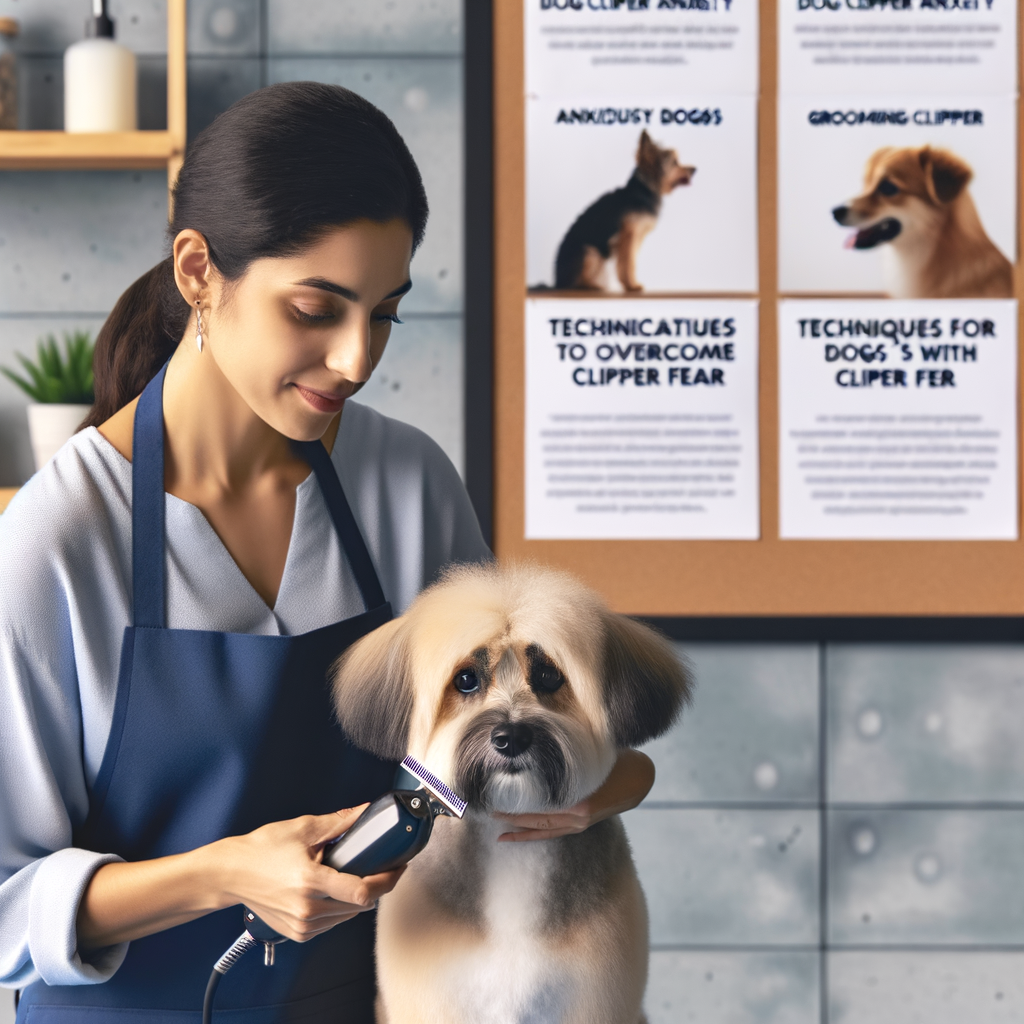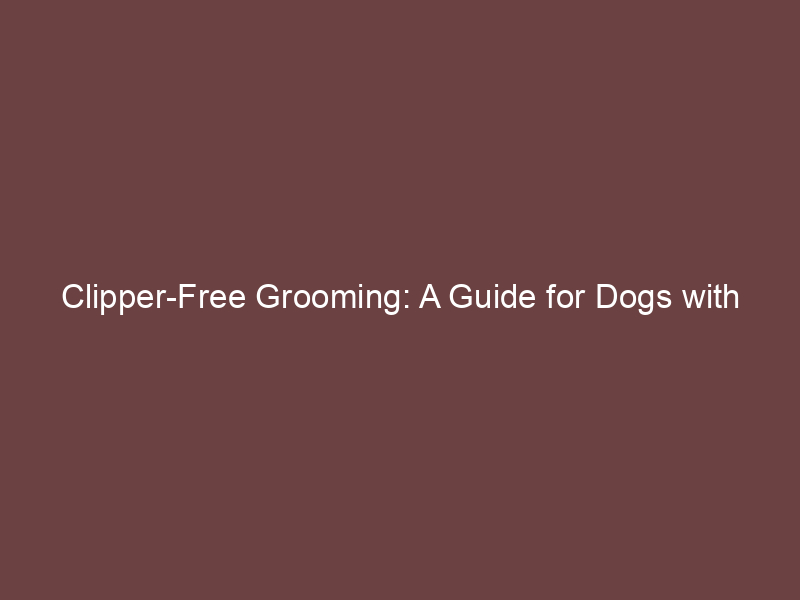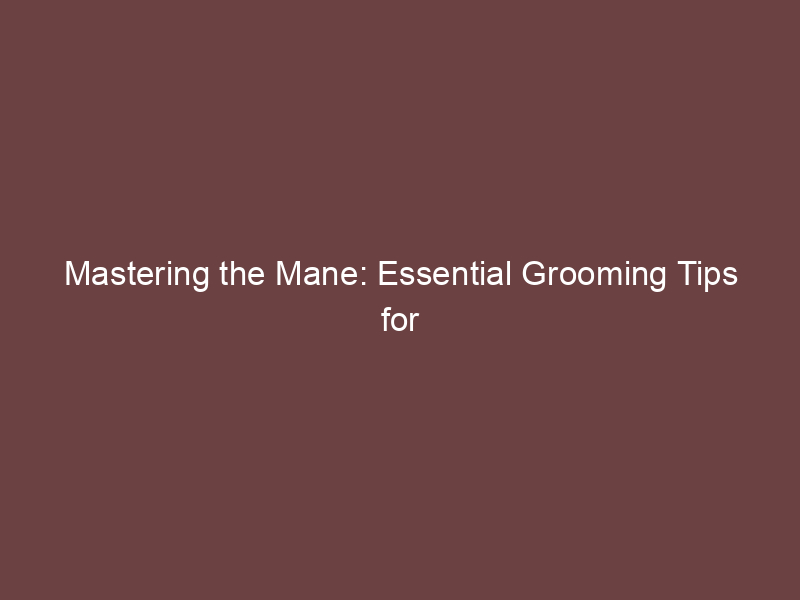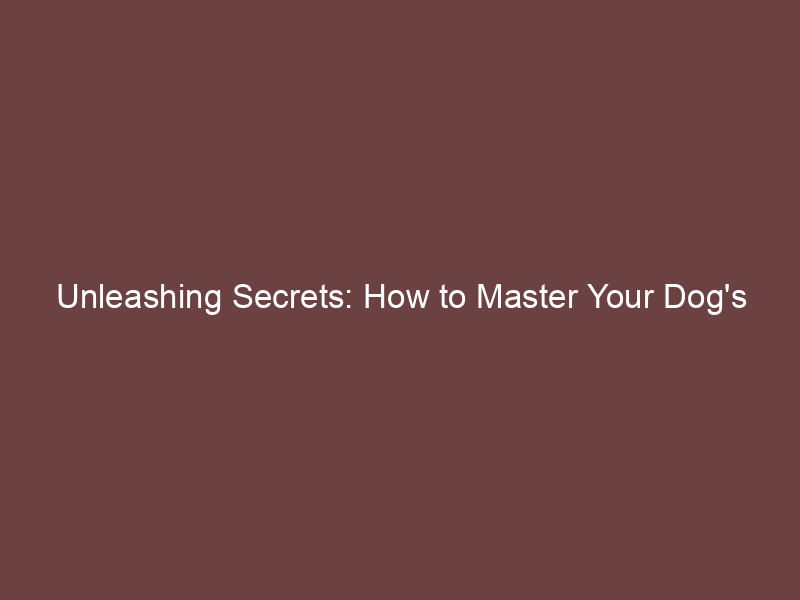
Introduction to Dog Grooming
As a dog owner, you know that your furry friend needs more than just food and love. One of the essential aspects of maintaining your dog’s health and happiness is regular grooming. This introductory guide will shed light on the importance of regular grooming for dogs and discuss some common challenges that dog owners face during the grooming process.
- The Importance of Regular Grooming for Dogs
- Common Challenges in Grooming Dogs
Grooming is not just about keeping your dog looking good. It’s about maintaining their physical health. Regular grooming can prevent a variety of health problems, such as skin irritations and infections, matting, and dental issues. It also provides an opportunity to check for any abnormalities like lumps, ticks, or fleas. According to a survey by the American Pet Products Association, 38% of dog owners groom their dogs at home, highlighting the importance of understanding the grooming process.
Grooming a dog can be a challenging task, especially for new pet owners. Some dogs may be afraid of the grooming process, particularly when it comes to nail trimming and hair cutting. Other challenges include dealing with a dog’s sensitive skin, handling a dog that doesn’t like water, and managing a dog that gets anxious when being groomed. It’s essential to approach these challenges with patience and understanding to make the grooming experience as comfortable as possible for your pet.
In the following sections, we will delve deeper into understanding dogs’ fear of clippers, how to groom a fearful dog, and overcoming clipper fear in dogs. We will also share some real-life case studies to provide practical insights into dealing with dog clipper anxiety.
Understanding Fear of Clippers in Dogs
One common issue that pet owners often encounter when grooming their dogs is a fear of clippers. This fear can make the grooming process stressful for both the dog and the owner. To help alleviate this fear, it’s important to understand what clipper anxiety is and how to recognize its signs.
What is Clipper Anxiety?
Clipper anxiety, also known as clipper fear, is a type of fear that dogs may develop towards grooming clippers. This fear can stem from various factors, such as past traumatic experiences or sensitivity to the noise and vibrations of the clippers. Understanding clipper anxiety is the first step towards helping your dog overcome this fear.
- Definition of Clipper Anxiety
- Common Signs of Clipper Fear in Dogs
- Shaking or trembling when the clippers are turned on
- Attempting to escape or hide when the clippers are brought out
- Whimpering or barking at the sight or sound of the clippers
- Aggressive behavior, such as growling or snapping, when the clippers are near
Clipper anxiety refers to a dog’s fear or apprehension towards grooming clippers. It’s a specific type of fear that can make grooming a challenging task. This fear is often characterized by signs of distress, such as shaking, whimpering, or trying to escape when the clippers are present.
Recognizing the signs of clipper fear in your dog is crucial for addressing the issue. Some common signs include:
By understanding what clipper anxiety is and recognizing its signs, you can take the necessary steps to help your dog feel more comfortable during grooming sessions. Remember, patience and understanding are key when dealing with a fearful dog.
Causes of Clipper Anxiety
Clipper anxiety in dogs can be caused by a variety of factors. Understanding these causes is the first step towards helping your pet overcome their fear. Here are the three most common causes:
- Past Traumatic Experiences
- Lack of Exposure to Grooming Tools
- Sensitivity to Noise and Vibration
Just like humans, dogs can also have traumatic experiences that can lead to long-term fear or anxiety. If a dog has had a painful or scary experience with clippers in the past, they may associate the tool with that negative experience. This could be a grooming session that went wrong, or an inexperienced groomer who accidentally hurt the dog. These experiences can cause a dog to become anxious whenever they see, hear, or even just sense the presence of clippers.
Dogs who are not regularly groomed or who were not exposed to grooming tools at a young age may be afraid of clippers. This is because the tools are unfamiliar to them, and dogs, like many animals, fear what they don’t understand. Regular grooming from a young age can help a dog get used to the tools and processes, reducing their fear over time.
Clippers can be loud and they vibrate when in use. Some dogs are particularly sensitive to noise and vibration, which can make them anxious. The sound of the clippers, combined with the sensation of the vibration, can be overwhelming for these dogs. In some cases, the dog may not be afraid of the clippers themselves, but rather the noise and vibration they produce.
Understanding these causes can help you and your groomer work together to create a grooming experience that is less stressful for your dog. Remember, patience and understanding are key when dealing with a dog who has clipper anxiety.
How to Groom a Fearful Dog
Grooming a fearful dog can be a challenging task. However, with the right approach and preparation, it can be made easier and less stressful for both you and your pet. Here are some steps to prepare your dog for grooming.
Preparation for Grooming
Preparation is key when it comes to grooming a fearful dog. By creating a calm environment and introducing grooming tools gradually, you can help your dog feel more comfortable and less anxious.
- Creating a Calm Environment
- Introducing Grooming Tools Gradually
One of the first steps in preparing to groom a fearful dog is to create a calm and quiet environment. This can be done by choosing a quiet room in your house, away from other pets and distractions. You can also play soft music or use a white noise machine to help soothe your dog. It’s also important to remain calm and patient yourself, as dogs can pick up on our emotions.
Another important step is to introduce grooming tools to your dog gradually. Start by showing your dog the grooming tools and let them sniff and explore them. You can also use treats to create positive associations with the tools. Start with short grooming sessions and gradually increase the duration as your dog becomes more comfortable. Remember, the goal is to make grooming a positive experience for your dog.
In conclusion, grooming a fearful dog requires patience, understanding, and the right preparation. By creating a calm environment and introducing grooming tools gradually, you can help your dog overcome their fear and make grooming a more enjoyable experience for both of you.
Clipper-Free Grooming Techniques
For dogs who are fearful of clippers, there are several clipper-free grooming techniques that can help keep your pet looking their best. These methods are not only effective, but they can also help reduce anxiety and stress during grooming sessions.
- Using Scissors for Trimming
- Brushing Techniques for Removing Mats
- Bathing and Drying Tips
Scissors can be a great alternative to clippers for trimming your dog’s fur. They are quiet, which can be less scary for a nervous dog. When using scissors, it’s important to be gentle and patient. Start by trimming small amounts of fur at a time, and always cut in the direction of hair growth to avoid pulling or tugging. Remember to use blunt-tipped scissors to prevent accidental injuries.
Regular brushing is essential for preventing mats and tangles in your dog’s fur. For dogs with long or curly hair, a slicker brush or a comb with wide teeth can be particularly effective. When you encounter a mat, hold it at the base to avoid pulling on your dog’s skin, and gently work through it with the brush or comb. If a mat is too large or tight to brush out, it may need to be carefully cut out with scissors.
Bathing your dog can help remove loose hair and dirt, and it’s an important part of the grooming process. Use a dog-friendly shampoo and warm water, and be sure to rinse thoroughly to avoid leaving any soap residue on your dog’s skin. After the bath, towel dry your dog as much as possible. For dogs who are afraid of the noise of a hair dryer, consider using absorbent pet towels or a low-heat setting on the dryer.
Remember, the goal of grooming is not only to keep your dog looking great, but also to make the experience as comfortable and stress-free as possible. By using these clipper-free techniques, you can help ensure that your dog stays clean and happy.
Overcoming Clipper Fear in Dogs
Many dogs experience fear and anxiety when it comes to grooming, particularly when clippers are involved. However, there are effective training techniques that can help your furry friend overcome this fear. Let’s explore a couple of these methods.
Training Techniques
There are two main training techniques that can be used to help dogs overcome their fear of clippers: positive reinforcement and desensitization and counter-conditioning. These methods are not only effective but also promote a positive relationship between you and your pet.
- Positive Reinforcement
- Desensitization and Counter-Conditioning
Positive reinforcement involves rewarding your dog for desirable behavior. In the context of overcoming clipper fear, this could mean giving your dog a treat or praise when they remain calm in the presence of the clippers. This method encourages your dog to associate the clippers with positive experiences, thereby reducing their fear.
Desensitization involves gradually exposing your dog to the clippers in a non-threatening way. Start by showing your dog the clippers without turning them on. Once your dog is comfortable with the sight of the clippers, turn them on at a distance. Gradually decrease the distance until your dog is comfortable with the sound of the clippers close by.
Counter-conditioning, on the other hand, involves changing your dog’s emotional response to the clippers. This can be achieved by associating the clippers with something your dog loves, like their favorite treat or toy. Over time, your dog will begin to associate the clippers with these positive experiences, reducing their fear.
Remember, patience is key when using these techniques. It may take some time for your dog to overcome their fear of clippers, but with consistent training and plenty of positive reinforcement, they will eventually become more comfortable with the grooming process.
Professional Help
While we can do a lot to help our dogs overcome their fear of clippers, sometimes it’s best to seek assistance from a professional. Let’s discuss when to seek help and how a professional can assist.
- When to Seek Help from a Professional Groomer
It’s important to recognize when your dog’s fear of clippers is beyond your ability to handle. If your dog exhibits extreme anxiety or aggression during grooming, it may be time to seek professional help. Other signs include:
- Excessive shaking or trembling
- Attempts to escape or hide
- Refusal to allow you to touch certain areas
These signs indicate that your dog’s fear is severe and requires the expertise of a professional groomer who is trained to handle such situations.
- How a Professional Can Help with Clipper Fear
Professional groomers have the training and experience to handle dogs with clipper fear. They use a variety of techniques to help dogs feel more comfortable, such as:
- Slow Introduction: A professional groomer will introduce the clippers slowly, allowing the dog to become familiar with the sight and sound before they start grooming.
- Positive Reinforcement: Groomers often use treats, praise, and other forms of positive reinforcement to help dogs associate grooming with positive experiences.
- Special Equipment: Some groomers use special clippers that are quieter or have lower vibrations to make the experience less scary for dogs.
Remember, a professional groomer’s goal is to ensure your dog’s comfort and safety during grooming. They have the knowledge and tools necessary to help your dog overcome their fear of clippers.
Dealing with Dog Clipper Anxiety: Case Studies
Let’s delve into some real-life examples that highlight how dog owners and professional groomers have successfully managed dog clipper anxiety. These case studies will provide practical insights and strategies that you can apply to help your furry friend overcome their fear of clippers.
- Case study 1: Overcoming clipper fear through gradual exposure
- Case study 2: Successful grooming with clipper alternatives
Meet Bella, a two-year-old Golden Retriever who was terrified of grooming clippers. Bella’s owner, Sarah, decided to take a gradual approach to help Bella overcome her fear. She began by introducing the clippers to Bella without turning them on. She allowed Bella to sniff and explore the clippers, rewarding her with treats for her bravery.
Over the next few weeks, Sarah gradually increased Bella’s exposure to the clippers. She would turn them on at a distance, allowing Bella to get used to the sound. Eventually, Sarah was able to trim a small section of Bella’s fur while the clippers were on. This process took several weeks, but Bella’s fear of the clippers significantly decreased.
Through patience and gradual exposure, Sarah was able to help Bella overcome her fear of clippers. This case study highlights the importance of taking things slow and rewarding positive interactions with the clippers.
Next, we have Max, a three-year-old Border Collie who would panic at the sight of clippers. Max’s groomer, John, decided to try clipper alternatives to make the grooming process less stressful for Max.
John started using a grooming glove to brush Max’s fur. This glove mimics the feeling of being petted, which Max found comforting. For areas that needed more precise grooming, John used grooming scissors. He made sure to use scissors with rounded tips to ensure Max’s safety.
By using clipper alternatives, John was able to groom Max without causing him stress or anxiety. This case study demonstrates that there are other grooming tools available if your dog has a severe fear of clippers.
These case studies show that with patience, understanding, and the right approach, it’s possible to help your dog overcome their fear of grooming clippers. Remember, every dog is unique, and what works for one might not work for another. It’s important to find a method that works best for your dog.
Conclusion: Calming Dogs During Grooming
As we conclude this comprehensive guide on calming dogs during grooming, it’s crucial to remember that every dog is unique. Their reactions to grooming and specifically to clippers can vary widely. However, with the right approach, patience, and understanding, you can help your furry friend overcome their fear and anxiety. Let’s recap some of the key takeaways and the importance of patience and understanding in dealing with dog clipper anxiety.
- Key takeaways for grooming dogs with clipper fear:
- Importance of patience and understanding in dealing with dog clipper anxiety:
Firstly, it’s essential to understand your dog’s fear. Is it the noise of the clippers, the vibration, or the sensation of the clippers on their skin? Once you’ve identified the source of their fear, you can begin to desensitize them gradually. This process should be slow and steady, allowing your dog to become comfortable at each stage before moving on to the next.
Secondly, make grooming a positive experience. Reward your dog with treats, praise, or playtime after a grooming session. This positive reinforcement can help them associate grooming with good things, reducing their fear over time.
Lastly, consider professional help if needed. Some dogs may have severe anxiety that requires the assistance of a professional dog trainer or behaviorist. Don’t be afraid to seek help if you’re struggling to manage your dog’s fear on your own.
Patience and understanding are key when dealing with a dog that has clipper anxiety. It’s important to remember that your dog is not being difficult on purpose. They are genuinely scared and need your help to overcome their fear.
Being patient means taking the time to desensitize your dog to the clippers slowly, without rushing the process. It also means stopping the grooming session if your dog becomes too stressed, even if you haven’t finished grooming them.
Understanding your dog’s fear and anxiety can help you empathize with them and approach the situation with kindness and compassion. Remember, your goal is not just to get your dog groomed, but to help them feel safe and comfortable during the process.
In conclusion, grooming your dog doesn’t have to be a stressful experience for either of you. With patience, understanding, and the right approach, you can help your dog overcome their fear of clippers and make grooming a positive experience for both of you.





